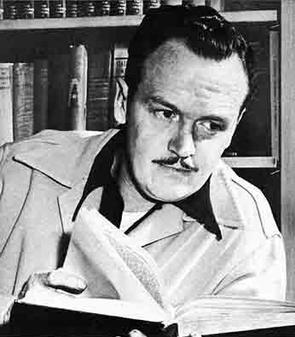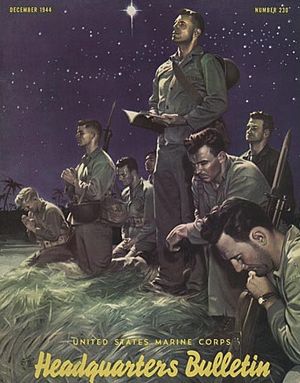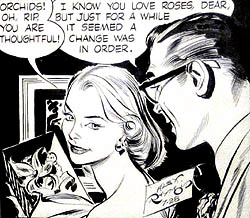Alex Raymond facts for kids
Quick facts for kids Alex Raymond |
|
|---|---|

Promotional photograph of Alex Raymond from King Features' Famous Artists and Writers, 1949
|
|
| Born | Alexander Gillespie Raymond Jr. October 2, 1909 New Rochelle, New York, U.S. |
| Died | September 6, 1956 (aged 46) Westport, Connecticut, U.S. |
| Nationality | American |
| Area(s) | Cartoonist, Artist |
|
Notable works
|
Flash Gordon Rip Kirby |
| Awards | Reuben Award (1949) Comic Book Hall of Fame (1996) |
Alexander Gillespie Raymond Jr. (born October 2, 1909 – died September 6, 1956) was an American cartoonist. He is best known for creating the famous Flash Gordon comic strip in 1934 for King Features Syndicate. This comic strip later became popular in movies and TV shows.
Raymond's father loved drawing and encouraged him to draw from a young age. In the early 1930s, Raymond became an assistant artist for comic strips like Tillie the Toiler and Tim Tyler's Luck. In late 1933, he created the exciting science fiction comic strip Flash Gordon. This strip was made to compete with the popular Buck Rogers comic. Soon, Flash Gordon became even more popular.
Raymond also worked on the adventure comic Jungle Jim and the spy comic Secret Agent X-9 at the same time as Flash Gordon. However, he had too much work, so he left Secret Agent X-9 to another artist by 1935. In 1944, he joined the Marines and fought in World War II. After the war, in 1946, Raymond created and drew Rip Kirby, a comic strip about a private detective. Sadly, Alex Raymond died in a car crash in 1956 when he was 46 years old.
He was known as "the artist's artist" because of his unique and often copied drawing style. Many artists have said that Raymond inspired their work. These include famous comic artists like Jack Kirby, Bob Kane, Russ Manning, and Al Williamson. George Lucas, the creator of Star Wars, also said Raymond was a big influence. Raymond was added to the Will Eisner Comic Book Hall of Fame in 1996.
Contents
Who Was Alex Raymond?
Early Life and Starting His Career
Alex Raymond was born in 1909 in New Rochelle, New York. His parents were Beatrice W. and Alexander Gillespie Raymond, Sr. His family raised him in the Roman Catholic faith.
His father was a civil engineer who loved drawing. He encouraged young Alex to draw from an early age. Raymond's father died when Alex was 12. After this, Alex felt that a career in art might not be as good as he hoped. He attended Iona Prep on a sports scholarship.
Raymond's first job was as a clerk on Wall Street. After the 1929 economic crisis, he went to the Grand Central School of Art in New York City. He also started working for a mortgage broker.
Soon, Raymond met his old neighbor, Russ Westover. By 1930, Raymond was helping Westover with his Tillie the Toiler comic strip. This led Raymond to work for King Features Syndicate, where he would create his most famous art.
Raymond was inspired by many cartoonists and illustrators. From 1931 to 1933, he helped Lyman Young with Tim Tyler's Luck. He became the main artist for the daily and Sunday pages, making it a very popular strip. At the same time, Raymond also helped Chic Young with Blondie.
In 1933, King Features asked him to draw an action-adventure spy strip called Secret Agent X-9. The story was written by the novelist Dashiell Hammett. Raymond's detailed drawing style for this strip made him a top artist at King Features.
Creating Flash Gordon, Jungle Jim, and Secret Agent X-9
In late 1933, King Features wanted Raymond to create a Sunday comic page. They wanted it to compete with Buck Rogers in the 25th Century, a popular science fiction strip. The president of King Features, Joe Connolly, gave Raymond an idea. It was based on amazing adventures like those in Jules Verne's books.
Raymond worked with writer Don Moore, who wrote for pulp-fiction stories. Together, they created the visually stunning science fiction comic strip Flash Gordon. They also created Jungle Jim, an adventure story set in Southeast Asia. This strip often appeared above Flash Gordon in newspapers. Raymond was also drawing Secret Agent X-9 at the same time. Flash Gordon quickly became more popular than Buck Rogers.
Flash Gordon first appeared on January 7, 1934. It introduced a "world-famous polo player" named Flash Gordon. He was pulled into a space adventure with his girlfriend, Dale Arden, and a scientist, Dr. Hans Zarkov. They traveled by rocket to the planet Mongo, which was about to crash into Earth. There, they met the evil warlord, Ming, who became Flash Gordon's main enemy.
In early 1935, Dashiell Hammett left Secret Agent X-9 to work in Hollywood. Raymond took over the writing for a short time. By the end of 1935, Raymond had too much work. He left Secret Agent X-9 to artist Charles Flanders. This allowed him to focus more on his detailed Sunday pages.
Raymond's artwork was very detailed and beautiful. He studied popular illustrators to create his style. His work on Flash Gordon made him one of the most respected artists in comics. He changed the layout of the strip over time. He went from four rows of panels in 1934 to two rows in 1936. This made the panels larger. He also moved the dialogue from speech balloons to captions at the bottom. This gave him more space for detailed backgrounds.
Flash Gordon also got a daily strip in 1940, drawn by Austin Briggs. Raymond left the Sunday strip in 1944 to join the Marines. Briggs then took over the Sunday strip until 1948.
Raymond's Jungle Jim strip was also very beautiful. It was set in modern times in the exotic Malay peninsula. It aimed to remind readers of classic adventure tales by authors like Rudyard Kipling and Edgar Rice Burroughs.
Serving in the Military
Raymond felt strongly about the war in Europe. He even included war themes in his comic strips. Flash Gordon returned to Earth in 1941, and Jungle Jim fought in the U.S. Army. Raymond wanted to do his part, especially since four of his five brothers had already joined the military.
In February 1944, Raymond left King Features and his work on Flash Gordon and Jungle Jim. He joined the U.S. Marine Corps as a captain. He worked in public relations. Raymond said, "I just had to get into this fight."
He was sent for training and soon created posters and patriotic images. His most famous image from this time is "Marines at Prayer." This painting showed Marines on a battlefield praying. Raymond also designed the official 1944 Marine Corps Christmas card. He wanted to be closer to the fighting. He trained again and served in the Pacific Ocean theater in 1945. His fellow Marines, who grew up reading Flash Gordon, saw him as a celebrity. He was well-liked and down-to-earth. He saw intense fighting in June 1945.
He left the Marines in 1946 as a major. When he returned, Raymond could not go back to Flash Gordon. King Features had given the strip to Austin Briggs. Raymond was upset by this, but King Features offered him a chance to create a brand new comic strip.
Creating Rip Kirby
Raymond's new comic strip was about a private detective named J. Remington "Rip" Kirby. It started on March 4, 1946. The editor, Ward Greene, helped create the story ideas. Raymond was the main artist, and his name was a big selling point for the strip. He even got a special deal to own part of the comic and get a better share of the profits. Rip Kirby was Raymond's first comic strip after the war. He created a new, modern style for it.
Rip Kirby was an ex-Marine, just like Raymond. He became a private detective, which was perfect for daily adventures. The strip was different from typical detective stories. Rip thought more than he fought. He smoked a pipe while thinking. He had a frail assistant instead of a tough sidekick. He also had a steady girlfriend and wore glasses.
Rip lived and worked in a realistic, glamorous New York City. His cases involved human weaknesses and problems. Rip also grew older as the strip went on, which was unusual for comics at the time. Raymond said, "I wanted to do something different and more down to earth."
Raymond's new drawing style for Rip Kirby was very influential. It became known as 'the Raymond style'. Even though the strip was in black and white, Raymond used different line work to create a sense of tone and contrast.
The comic strip became very popular. Raymond received the Reuben Award in 1949 for his work on Rip Kirby. He also served as the president of the National Cartoonists Society from 1950 to 1952. He worked hard to promote comic art. Raymond continued to draw Rip Kirby until his death in 1956. Writer Fred Dickenson worked with him from 1952. After Raymond's death, John Prentice took over the artwork. Prentice continued to draw Rip Kirby until he died in 1999, and the strip ended a month later.
Alex Raymond's Lasting Influence
Alex Raymond's influence on other cartoonists was huge during his life and continued after his death. Time magazine called him "some sort of genius" in 1974. Many people say he was perhaps the most influential artist in early comic books. Raymond and Hal Foster (who drew Prince Valiant) set the standard for adventure comic strips. His work on Rip Kirby also inspired many "soap opera" style comic strips of the 1950s and 1960s.
Raymond's realistic drawing style was sometimes criticized for being too beautiful. However, many people believe this style pulled readers into the story. His work has a "timeless appeal." His techniques, like "feathering" (a shading method using parallel lines), have inspired many cartoonists. His work became a source of ideas for future artists. His work on Rip Kirby is especially known for its "sophisticated black spotting." This is a technique he used to create dark areas for pacing in the strip. Fellow cartoonist Stan Drake said Raymond called these black areas "pools of quiet."
Many famous artists have said Raymond was a key influence. George Lucas said Raymond's Flash Gordon was a major influence on his Star Wars films. This then inspired the 1980 Flash Gordon movie. Al Williamson, a famous comic artist, said Raymond was "the reason I became an artist." Williamson even helped draw Flash Gordon and Rip Kirby after Raymond's death.
The creators of Batman (Bob Kane) and Superman (Joe Shuster) also said Raymond greatly influenced their art. Jack "King" Kirby, who co-created many Marvel Comics heroes, also named Raymond as a big inspiration.
Personal Life
Alex Raymond married Helen Frances Williams on December 31, 1930. They had five children together. The names of his three daughters—Judith, Lynne, and Helen—were used for Rip Kirby's girlfriend, Judith Lynne "Honey" Dorian. The Raymonds also had two sons, Alan W. and Duncan. He was the great-uncle of actors Matt Dillon and Kevin Dillon. His younger brother, Jim Raymond, was also a cartoonist. He worked as an assistant on the Blondie comic strip.
His Death
On September 6, 1956, Alex Raymond died in a car accident in Westport, Connecticut. He was 46 years old. He was driving fellow cartoonist Stan Drake's car. The car was going twice the speed limit when it hit a tree. It had started to rain, and Raymond decided to drive faster to reach his destination instead of stopping to put the car's top up. Drake was thrown from the car, but Raymond, who was wearing his seat belt, died instantly. Raymond was buried in St. John's Roman Catholic Cemetery in Darien, Connecticut.
Awards and Recognition
Alex Raymond received a Reuben Award from the National Cartoonists Society in 1949 for his work on Rip Kirby. He later served as president of the society in 1950 and 1951. He was inducted into the Will Eisner Comic Book Hall of Fame in 1996. In 2014, he was also inducted into the Society of Illustrators Hall of Fame.
Maurice Horn, a comics historian, called Raymond "one of the most celebrated comic artists of all time." He noted that Raymond created four outstanding comic features, which is a rare achievement. Raymond received many awards during his lifetime for his work as both a cartoonist and a magazine illustrator.
Images for kids
-
The first Flash Gordon and one from 1936 show how Raymond expanded from the standard layout to larger panels.
See Also
 In Spanish: Alex Raymond para niños
In Spanish: Alex Raymond para niños





